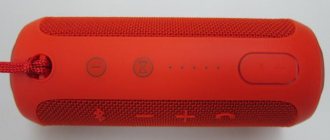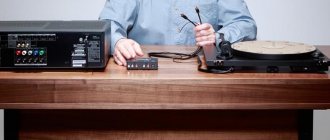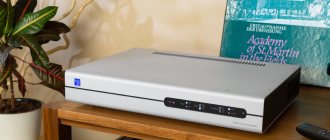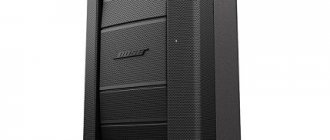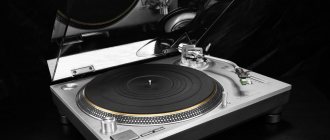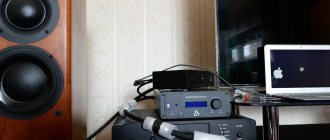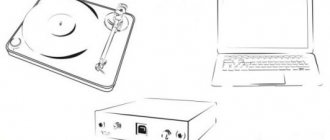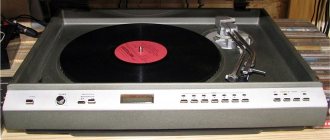You have decided to join the world of vinyl. Nostalgia, an old collection (my case), a tribute to fashion or another reason - it doesn’t matter. Now it is important to implement the solution in specific components. The choice of phono preamp, along with the turntable and cartridge, is key. And if there are already selected options for turntables and cartridges, then the choice of a phono stage is not so obvious. Meanwhile, the influence of the phono stage on the sound of the resulting vinyl system can hardly be overestimated.
First, briefly about why you need a phono preamplifier. A recording on a vinyl record has a nonlinear frequency response. Actually, the phono preamplifier levels out this nonlinearity and amplifies the sound signal coming from the pickup of the vinyl player. This is such a specialized pre-amplifier.
Typically, the first vinyl system chosen is inexpensive: a MM pickup, a turntable that minimally matches the selected pickup, and a phono stage. A little less than a year ago I made my first choice: the Pro-Ject X1 turntable (at the time of purchase it cost 58,000 rubles) and the Ortofon 2M Blue pickup (cost 13,800 rubles).
It is these components that I will try to match with a phono preamplifier in order to form a balanced vinyl setup. Naturally, phono preamps are for the MM pickup. In the price category about 20,000 rubles.
I use a stereo amplifier PAS-240, model 6 from and the author's acoustic system ASP Optimus Classic SB II from Alexander Serashov. To connect the player to the phono stage, use a standard RCA cable with grounding (included with the Pro-Ject X1 player) - Pro-Ject Connect IT. To connect the phono preamplifier to the amplifier, a simple non-name RCA cable is used that costs 1,000 rubles per pair.
Musical material used to evaluate sound:
The Beatles "Abbey Road" - 2022, 50th Anniversary Edition
Pink Floyd "The Dark Side Of The Moon" - 2016, Pink Floyd Music Ltd.
W. A. Mozart “Requiem”, Herbert von Karajan – 1968, Deutsche Grammophon
JSBach "Selected Compositions for Pipe-Organ-1", Lionel Rogg, Organ of Grossmunster Zurich, Record by Harmonia Mundi - 1969, Balkanton
Joseph Kobzon “Moon Rhapsody” - 1984, Melody
The following phono stages were tested during testing:
(prices for phono stages, hereinafter, are given at the time of writing 11/20/2020)
Nikitin phono stage - replica from K. Babin (Moscow), worth 12,000 rubles.
Phono stage PS Audio PS-II Mk5 - replica from K. Babin (Moscow), worth 20,000 rubles.
Tube phono preamplifier CleverAudio V3000 from A. Melnikov (St. Petersburg), costing 17,900 rubles.
Orbital Audio XL phono stage from A. Fefelov (St. Petersburg), worth 20,000 rubles.
Phono stage Pro-Ject Phono Box S2 worth 14,000 rubles.
Cambridge Audio Solo phono stage costs 18,490 rubles.
Phono stage Rega Fono MM worth 25,500 rubles.
Phono preamplifier Lehmann Audio Black Cube Statement worth 44,436 rubles.
Listening results:
Nikitin phono stage - replica from K. Babin (Moscow)
Sound: "meaty". A little more bass. A little brighter than I would like. Kind of a little rude. Although sometimes it’s impressive. Compared to the built-in phono preamplifier in the Marantz PM-66SE amplifier, it is much better.
Resolution: low.
Stage depth: poorly defined.
Detail: less than we would like.
Construction: the corrector consists of the corrector itself and a massive power supply that is plugged into an outlet. No adjustments are provided. The power switch is on the rear panel of the phono stage. Thus, the power supply is constantly connected to the network.
The power indicator is a red LED on the front panel of the phono stage. The glow is not bright. Doesn't irritate.
Circuit design: transistor.
Design: no design.
Warranty: 1 year.
Purpose: for MM and MC heads with high output.
Examples of finished structures
All metal parts should be connected to the "Common" wire (GND) at one point, usually at the input of the preamp board.
Especially for the site Electrical Schemes - Andrey Vladimirovich Baryshev
- PREAMP FOR RECORD PLAYER
- VINYL PREAMPLIFIER RIAA
- PHONO EQUIPMENT DIAGRAM FOR VINYL
- SIMPLE PHONO PREAMPLIFIER
Phono stage PS Audio PS-II Mk5 - replica from K. Babin (Moscow)
Sound: unexpectedly accurate and detailed. Everything in moderation. At first it seems like there is a lack of bass. But then the Grossmünster organ sounded - and the bass showed itself. The detailing is such that the outline of the instruments can be heard throughout the entire musical material. Even Requiem, a difficult piece to play from vinyl, plays satisfactorily, although I understand that an MC-head is needed here.
“Come Together” introduces depth to the stage. And the restrained recording of “The Far Side of the Moon” doesn’t sound so restrained. Particularly impressive is the enchanting quality of Kobzon’s melodiev sound. Yes, not Magomayev - Kobzon cannot have such power, but the velvety baritone - probably the best on the stage of the Union - sounds very beautiful.
Resolution: high.
Stage depth: very pronounced.
Detail: high.
Construction: the phono stage consists of two identical parts - the phono stage itself and the power supply. They are connected to each other by a power cable. Power switch on the back of the power supply. Adjustments (inconvenient, possible only by removing the phono stage housing, although such adjustment is done once) of the input capacitance (pF): 100–150–220–250–320–370–470 (default - 150 pF).
Power-on indicators: red LEDs on the front panel of the phono stage and power supply. The glow is not bright. Doesn't irritate. Circuit design: transistor.
Design: utilitarian, no frills.
Warranty: 1 year.
Purpose: for MM and MC heads with high output.
↑ How did it all start?
At one time, I got rid of the Vega-110 and bought a more serious device - Elektronika-012.
And this device has more serious sound stuffing. However, listening to music with the participation of a standard node in the path connected a noise suppressor, a rumble filter, and other “what would it sound like if…” inside my head. Why assemble your own proofreader? Lamps? It seemed to me that this was not the best option. OU? Too simple, but what about the creative component of our hobby?
There is one circuit on transistors that interested me. Although no, I was interested in two at once.
Phono stage CleverAudio V3000 from A. Melnikov (St. Petersburg)
Sound: very solid, balanced. You can listen for hours without getting tired. A rare combination of precision and elasticity. The disadvantage is that the resolution is slightly lower than expected. I would like it to be just a little bit better. Hence, there is no such definition of any sound as in the previous phono stage (PS Audio PS-II Mk5). A little too much bass.
I think this tube phono stage is an excellent choice for a first vinyl system. And it's definitely worth the money. Of course, complex works - for example, Requiem - are difficult for this phono preamplifier to handle. But otherwise - very worthy! The output voltage is slightly lower than previous models. On one of the test recordings, the amplifier's overload protection is constantly triggered.
Resolution: good, but not outstanding.
Stage depth: very good.
Detail: good
Construction: the phono stage consists of a monoblock design, all switching is on the rear side. The lamps glow neatly. Power switch on the left side. On the front there is a wooden plate with an LED in the center. There are no adjustments.
Power-on indicators: red LED in the center of the wooden phono panel. The glow is bright. No need for bright.
Circuit design: tube.
Design: pretty, one might say. For a four.
Warranty: 3 years.
Purpose: for MM heads.
↑ Conclusions
Before publishing the article, I listened to the device for approx.
2 months, I did not find any noticeable flaws. As I wrote above: the sound is clean, transparent and airy. The low frequencies are a little too low for my taste. But this is due to the fact that I set the capacitor C5 to 1 µF instead of 2.2 µF. Unfortunately, I have not yet found good capacitors of suitable capacity. Overall, if you are looking for a good budget phono preamp that can be assembled in one evening using readily available parts, then this project is perfect for you!
Orbital Audio XL phono stage from A. Fefelov (St. Petersburg)
Sound: good balance between sound accuracy, brightness and resolution. The Requiem is presented very whole. Both “The Other Side of the Moon” and “Monastery Road” sound recognizable and dignified.
But less complex works - the organ - reveal a lack of resolution: there is not enough air. It's not that it didn't exist at all. No, there is air, but not as volumetric as in the PS Audio PS-II Mk5. And Kobzon’s very decent melodiev recording is presented extremely emotionally, and here, too, a slight lack of resolution is reflected - Kobzon’s velvet has become less audible.
The general impression of this phono preamplifier: the sound character is very similar to the PS Audio PS-II Mk5, but it is a little inferior in resolution, just a little. And a little too much bass. Slightly denser feed.
Resolution: adequate, but not outstanding.
Stage depth: good.
Detail: good.
Construction: monoblock phono stage. All communications are on the back side. Power switch on the back side. There are no adjustments.
Power indicators: white LED in the center of the front panel. The glow is moderate. But it could have been a little more subdued.
Circuit design: operational amplifiers.
Design: impressive for a designer model. The design is made with high quality, in black and white. The front panel is white, 5 mm thick, and looks decent. No gaps. Even the shock absorption is better than other models. Packaging cardboard box with printing.
Warranty: 1 year.
Purpose: for MM heads.
↑ Scheme of the current project
Fragment excluded. The full version is available to patrons and full members of the community.
The figure shows a diagram of my version. Don’t let the tricky resistor values confuse you, I just used Soviet carbon resistors such as BLP, VS and ULI, the values of the latter have different values from the standard series, but are easily selected with an accuracy of 1%, especially in correction chains. Pay 200 rubles. For 1 piece branded Allen Bradley or Kiwame I really don’t want!
Phono stage Pro-Ject Phono Box S2
Sound: amazingly accurate. The phono stage itself is very small and you don’t expect good sound from it. But here you go! Very cohesive, the sound balance is very touching. The bottom is elastic, the tops are detailed, but not sonorous or intrusive, and what is called - in moderation. The middle doesn't stick out. The resolution is very good, I would say sufficient and no more is required.
All the material that I chose for testing sounds noble and restrained with this phono preamplifier. Doesn't brighten, doesn't darken. The requiem was performed in one breath. In general, this is the case when you can write: I highly recommend it. Taking into account the price, mass of settings, support for not only MM but also MS heads, it is definitely the best choice.
Resolution: high.
Stage depth: well defined.
Detail: sufficient.
Design: the corrector consists of an elegant corrector and a small power supply that plugs into an outlet. The adjustments are displayed in the form of DIP switches on the lower plane of the corrector. You can configure: gain - 40/43 dB for MM and 60/63 dB for MC heads. Input impedance: 10,100 ohms, 1 kohms, 47 kohms. Input capacitance: 100, 200, 320, 420 pF. The button for turning on the ultra-low frequency suppressor is on the back surface. The power on/off button is on the front panel of the phono stage. Thus, the power supply is constantly connected to the network.
Power-on indicator: Blue LED on the front panel of the phono stage, which is convenient. The glow is not bright. Doesn't irritate.
Circuit design: I haven’t opened it, but judging by the size, it’s operational amplifiers..
Design: cute minimalism.
Warranty: 1 year.
Purpose: for MM and MC heads.
ULF input selector
The two stereo inputs (AUX and turntable) must be connected to the amplifier in order for one of the devices to be selected. It uses a dual analog multiplexer on a 4052 . It has a 2-bit address, one of the bits is permanently shorted to ground and the other is connected to ground via a 100k resistor and to VCC via a switch.
Cambridge Audio Solo phono stage
Sound: discreetly precise. The bass is fast and elastic. The highs are discreet. There are enough of them, they are just natural and not protruding. The middle is in place - the voice sounds natural and recognizable. In short: discreet nobility. The phono stage itself is neatly made in gray and white tones.
The Requiem is, perhaps, played out most seamlessly - the scene is excellent both in front and in depth. And the work itself, extremely sensual, added a slight lack of emotion from the proofreader himself. The resolution is such that it only emphasizes the accuracy of the feed. No more, no less. In general, a very balanced sound, maybe even a little dry.
Those works that were originally recorded emotionally - for example, Kobzon's "Moon Rhapsody" - sound very noble. All the material that I chose for testing sounds noble and restrained with this phono preamplifier. As for me, the phono stage is a little lacking in emotion.
Resolution: exactly found.
Stage depth: well defined.
Detail: sufficient.
Design: the phono stage is made in the form of a monoblock. Among the adjustments is the channel balance, displayed on the rear side. No more adjustments.
Power On/Off Button: On the front panel of the phono stage.
White LED: not bright. In the waiting position it is very delicate, but even in working condition the glow is not bright. Doesn't irritate.
Circuit design: I haven’t opened it, but judging by the size, it’s operational amplifiers..
Design: cute minimalism.
Warranty: 1 year.
Purpose: for MM heads
History of vinyl
Perhaps, for almost every person, a gramophone record evokes good associations, memories of those past times, and also evoke positive emotions and slightly worn cardboard envelopes for storing them, with photographs of once popular pop stars. It is a mistake to think that vinyl has sunk into the past; today’s youth and music lovers love to listen to vinyl in updated variations; it is worth noting that manufacturers of non-budget music equipment do not forget about vinyl records. Vinyl has received the right to a second life and is becoming more popular every day. Its history is complex and long, and its fate is connected with the development of technological progress, devices and players.
If we talk about the concept of a vinyl record, then it appeared in 1948, after the end of the Second World War, and the largest at that time, who managed to create “long records”, the material for them was vinylate, worked hard on their creation. It was thanks to this material and special technology to reduce the playback speed that “vinyls” appeared on which it was possible to record entire albums.
Today there are few vinyl producers, but they still exist. This is German, where specialists are slowly but surely reviving the production of vinyl records, and they are doing a great job.
I would like to note that vinyl sound sounds much better than CDs or mp3 files. The sound is more natural, deep, clear bass. The sound from a vinyl record is distinguished by its volume and fullness, it is rich and saturated.
Among other things, I release the latest new music on vinyl, and the tactile effect of vinyl is simply impossible to compare with anything else.
So, if you are a music lover and lover of high-quality music, we will discuss devices such as phono stages in more detail, we will talk about their main functions, advantages and possible disadvantages.
Rega Phono MM phono stage
Sound: bright, emotional. The bass is fast and elastic. The top is slightly oversized. Not that there were very many of them. But given the good resolution, they ring a little. The middle is a little inside - you want the voice to protrude a little forward. The phono stage itself is neatly finished in black.
Those works that are recorded with restraint (like the Grossmünster organ) sound perhaps the most interesting. But Kobzon’s emotional recording sounds with a slight emotional overlap and is a bit harsh. The Requiem was played unexpectedly neutrally. And “The Far Side of the Moon” is presented in moderation.
In my opinion, the phono preamplifier is a little bright, and the presentation of high frequencies could be softer. This manifests itself in different recordings in different ways: an emotional recording is presented with a little emotional overkill. But a neutral recording sounds new and fresh.
Resolution: high.
Stage depth: well defined.
Detail: high.
Design: the phono stage is made in the form of the corrector itself and a small remote power supply. No adjustments.
The power on/off button is on the front panel of the phono stage. When turned on, the “Rega” inscription in red lights up on the front panel - it doesn’t shine brightly. Doesn't irritate.
Circuit design: I haven’t opened it, but judging by the description, it’s transistor.
Design: cute minimalism.
Warranty: 1 year.
Purpose: for MM heads
↑ Housing
The next stage was the manufacture of the body. I asked a friend to use a machine to cut and bend a piece of roofing iron
I made the sides from plywood and covered them with stain. I screwed the base to the sides using a wooden bead.
I drilled the holes for the RCA sockets and power supply with a cone drill (a very convenient thing). This is what happened in the end.
Lehmann Audio Black Cube Statement Phono Preamplifier
Sound: energetic. The bass is fast and elastic. There's a little more highs than I wanted. But it is not loud and does not turn into brightness. Vocals are spot on. The stage is wide. And deep. Detail and resolution are good. The phono stage itself is neatly made in a minimalist design.
All test material appeared in a new sound. It's like we've moved into the next quality category. Yes, that is right! After all, the price of this phono preamplifier is twice as high as the rest of the test participants!
This phono stage was tested for two purposes: a) to find out whether the quality has increased significantly? b) if so, isn’t it time to start testing the next batch of phono stages in the price category of 50-60 TR? And the answer to both questions is YES!
Resolution: high.
Stage depth: high.
Detail: high.
Design: the phono stage is made in the form of the corrector itself and a small remote power supply.
Adjustments: selection of pickup type - MM/MC, selection of gain, selection of input impedance of the MC pickup.
Power on/off button - no. We turn it on/off by inserting/removing the power supply into/from the socket/s. Or the phono stage is always on. Inconvenient. When turned on, a blue LED next to the output terminals lights up. It doesn't shine brightly. Doesn't irritate.
Circuit design: I haven’t opened it, but judging by the description, it’s operational amplifiers.
Design: minimalism.
Warranty: 1 year.
Purpose: for MM and MC heads.
↑ Setup
The setup comes down to selecting cathode resistors to ensure rated anode currents. This mainly concerns the output tube, the anode current of which is 8 mA.
By the way, you can use another buffer lamp, for example 6N6P or 6S45P, but they eat more at the anode. As for the high overload capacity at the corrector input, the author of the article was absolutely right, which is confirmed by the photo:
The oscillogram shows that at an input level of 150 mV there is an undistorted sine wave of the correct shape.
↑ Details
All resistors are metal film, with a power of 0.25 W.
The required resistance of resistors R4, R7, R12 can be obtained either by selecting parts, or by making several summaries. It is advisable to choose high-quality capacitors. I replaced the electrolyte at the input with 1 microfarad film. Instead of the indicated transistors, you can use BC556C, BC557C (VT1); BC550C, 2N5088 (VT2, VT4); 2N3906, 2N4403, BC214 (VT3), however, the pin layout of transistors BC and 2N differs from 2SC. It is important to pay attention to correct ground wiring and shielding. A correctly assembled circuit does not require adjustment. With the selection of C1, in theory, you need to play with each specific pickup model.

